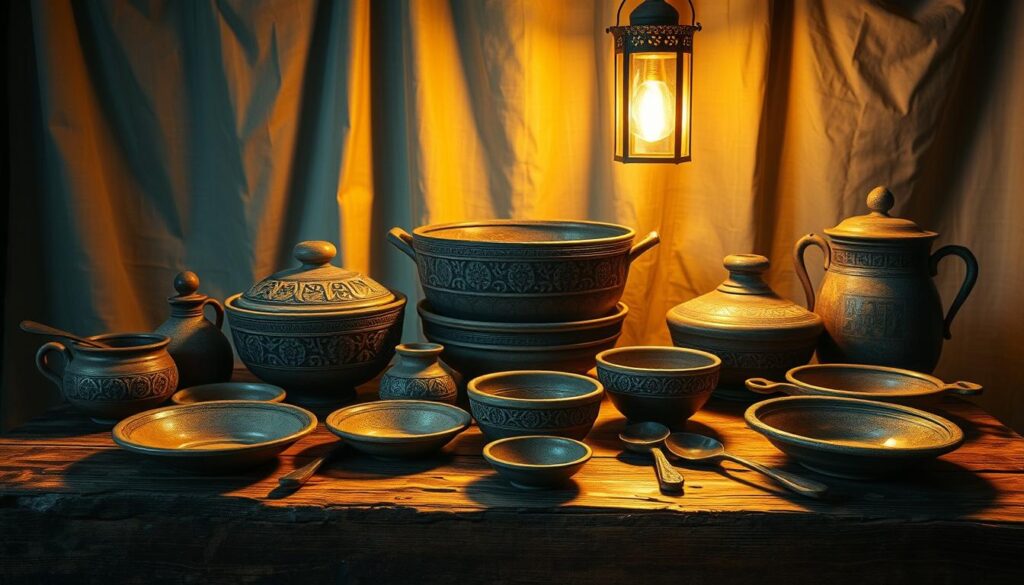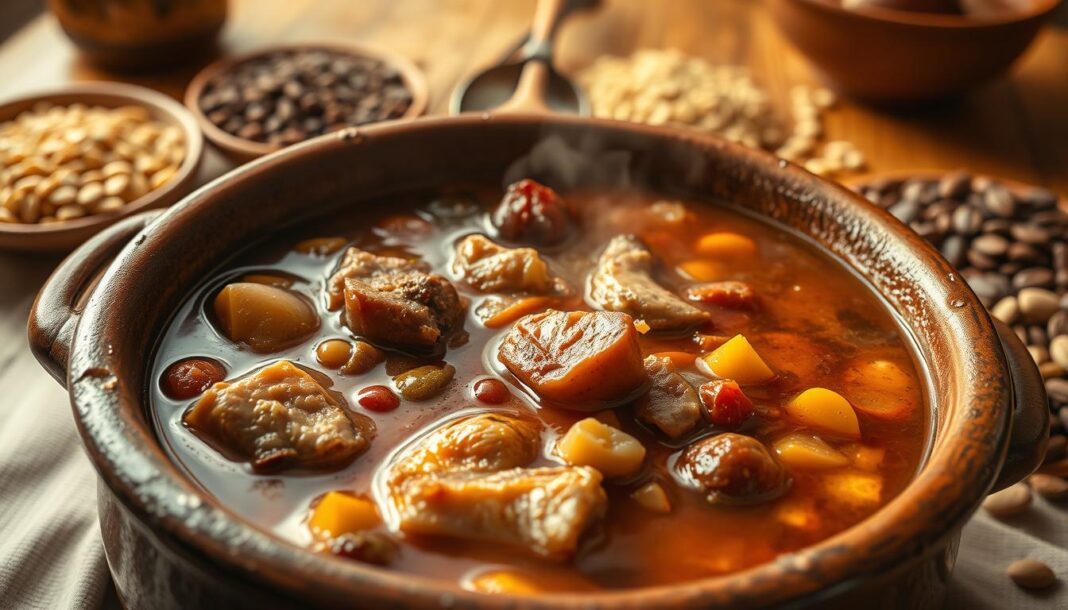We embark on a fascinating journey through the culinary traditions of our ancestors, exploring ancient dishes that have shaped the way we cook and enjoy food today.
For centuries, people have been preparing and savoring various recipes that have been passed down through generations, often with roots in historical events and cultural practices.
By examining these historical recipes and understanding how they were prepared, we gain valuable insights into the lives of our predecessors and the evolution of cuisine over the years.
Our exploration will reveal the ingenuity of cooks from a bygone century, showcasing how they utilized available ingredients to create nourishing and flavorful dishes.
Key Takeaways
- Exploring historical cuisine provides insights into cultural practices and trade routes.
- Many modern cooking techniques have roots in ancient culinary traditions.
- Archaeological evidence helps us understand and recreate historical recipes.
- Studying ancient cuisine reveals the continuity in human food preparation.
- Historical recipes offer a window into the lives of our ancestors.
The Culinary Legacy of Ancient Civilizations
As we explore the culinary legacy of ancient civilizations, we uncover the profound impact of food on the development of human societies. Over the span of roughly 5,000 years, from the emergence of Sumerian cuneiform script around 3,000 to 2,900 BCE to the fall of the Western Roman Empire in 476 CE, food played a crucial role in shaping cultures, trade networks, and technological innovations.
How Food Shaped Early Human History
Food preparation and consumption were fundamental to the development of early human societies, from Mesopotamia to ancient China. The ways in which ancient civilizations produced, processed, and consumed food not only reflected their cultural values and available resources but also influenced their social structures and technological advancements. For instance, the development of sophisticated culinary traditions in ancient Rome and ancient Greece was closely tied to their cultural identities and the resources available to them.

Archaeological Evidence of Ancient Cooking
Archaeological findings, including pottery, utensils, hearths, and food remains, provide tangible connections to past culinary practices. By studying these artifacts, archaeologists and food historians have been able to recreate ancient dishes and understand the evolution of cooking techniques over thousands of years. This not only sheds light on the daily lives of ancient people but also highlights the significant role that food played in shaping human history.
The study of ancient food remains helps us understand trade networks, agricultural practices, and technological innovations that were pivotal in the development of human societies. Moreover, the culinary legacy of these civilizations continues to influence modern cooking, with many dishes and techniques having direct lineage to recipes developed millennia ago.
Bread: The Foundation of Ancient Cuisine
The history of bread is a rich tapestry that weaves together the culinary practices, cultural traditions, and technological advancements of our ancestors. Bread is one of the oldest prepared foods, with evidence of bread-making dating back 14,000 years in Jordan.
Flatbreads and Early Baking Techniques
Flatbreads represent one of humanity’s earliest culinary innovations, made from simple ingredients and cooked using techniques that have remained largely consistent over millennia. The development of flatbreads was a significant milestone in the history of bread, showcasing early human ingenuity in food preparation.
Roman Focaccia and Other Historical Varieties
Ancient Roman bakers perfected focaccia and other varieties that bear a striking resemblance to breads we enjoy today. The art of bread-making in ancient Rome was not just about sustenance; it was also about creating dishes that were integral to daily life and ceremonies. Roman focaccia, in particular, remains a testament to the advanced baking techniques of the time.
Mantou and Eastern Bread Traditions
In contrast to Western bread-making traditions, Eastern cultures developed their own unique approaches to bread. Chinese mantou, dating back to the 3rd century BCE, represents a distinct method of bread-making that has been preserved through generations. The diversity in bread recipes across ancient civilizations highlights the adaptability and creativity of our ancestors in utilizing available ingredients to create staple foods.
| Bread Type | Origin | Historical Significance |
|---|---|---|
| Flatbread | Ancient Times | One of the earliest forms of bread, simple to make and cook. |
| Focaccia | Ancient Rome | Perfected by Roman bakers, showcasing advanced baking techniques. |
| Mantou | Ancient China (3rd century BCE) | Represents a distinct Eastern approach to bread-making. |
As we explore these ancient bread-making traditions, it becomes clear that bread was not just a staple food but a dish that held cultural and religious significance across various civilizations. The evolution of bread recipes based on available grains and technology, from simple ash-baked flatbreads to more complex leavened varieties, underscores the resourcefulness and innovation of our ancestors.
Ancient Dishes from Mediterranean Civilizations
As we explore the ancient dishes of Mediterranean civilizations, we uncover the intricate relationships between food, culture, and geography. The region’s diverse climate and geography played a significant role in shaping the culinary traditions of ancient Greece, Rome, and Egypt.
Greek Culinary Traditions
Ancient Greek cuisine emphasized simplicity and freshness, with dishes that celebrated local produce and reflected philosophical ideals about moderation. The Greeks prized ingredients such as olives, olive oil, and fresh seafood, which were abundant in the Mediterranean.
Roman Garum and Flavor Profiles
The Romans revolutionized flavor profiles with garum, a fermented fish sauce that added umami flavor to numerous dishes. Archaeological evidence, including the remains of garum factories in Baelo Claudia, Spain, highlights the significance of this condiment in Roman cuisine. Garum was used not only by the Romans but also by the Phoenicians and ancient Greeks, where it was known as γάρος.
Egyptian Food Preservation Methods
Egyptian cuisine developed sophisticated food preservation techniques, including drying, salting, and fermentation, to store food in the hot climate. These methods allowed for the long-term storage of grains, fruits, and vegetables, supporting a stable food supply.
| Civilization | Notable Ingredient/Technique | Culinary Characteristic |
|---|---|---|
| Ancient Greece | Olives and Olive Oil | Simplicity and Freshness |
| Roman Empire | Garum (Fermented Fish Sauce) | Complex Flavor Profiles |
| Ancient Egypt | Drying, Salting, Fermentation | Sophisticated Preservation |
The exchange of culinary practices among these Mediterranean civilizations enriched their respective cuisines, creating a lasting legacy in the culinary world. By examining these ancient practices, we gain insight into the evolution of modern cuisine and the enduring influence of ancient food traditions.
Eastern Delicacies Through the Ages
As we explore the culinary history of the East, we uncover a rich tapestry of flavors and techniques that have shaped cuisines across the globe. The Eastern world, encompassing China, India, and other ancient civilizations, has been a hotbed of culinary innovation, with a legacy that continues to influence modern cooking.
Chinese Culinary Innovations
Chinese culinary history spans thousands of years, with ancient dishes like congee and Anfu ham remaining staples in modern Chinese cooking. Congee, a rice porridge, has been a comfort food in China since ancient times, while Anfu ham, originating from the Qin dynasty, showcases the sophistication of ancient Chinese curing techniques.
Ancient Indian Curry and Spice Traditions
India’s culinary history is marked by the development of complex curry and spice traditions. The blending of indigenous and imported spices created rich flavor profiles that not only defined Indian cuisine but also spread throughout Asia, influencing various regional cuisines.
Fermentation Techniques in Asian Cuisine
Fermentation has been a cornerstone of Asian cuisine, preserving foods while creating distinctive flavors. From Korean kimchi to Japanese natto, fermentation techniques have contributed to the diversity and richness of Asian culinary traditions.
| Dish | Origin | Description |
|---|---|---|
| Congee | China | A traditional rice porridge consumed since ancient times. |
| Anfu Ham | China (Qin dynasty) | A dry-cured ham known for its distinctive flavor and texture. |
| Babaofan (Eight Treasure Glutinous Rice) | China ( Shang dynasty) | A ceremonial glutinous rice dish filled with various ingredients, symbolizing prosperity. |
The culinary traditions of the East have not only survived the test of time but continue to evolve, influencing global cuisine. By understanding and appreciating these ancient dishes and cooking techniques, we can gain a deeper insight into the cultural and historical contexts that shaped them.
Soups and Stews: Nourishment Across Civilizations
Across ancient civilizations, soups and stews served as fundamental dishes, offering both nourishment and flavor. These hearty preparations were not only a staple in many cultures but also represented a practical way to combine various ingredients, maximizing nutrition and flavor.
Mesopotamian Lamb Stew (1700 BCE)
One of the oldest written recipes in human history is the Mesopotamian lamb stew, documented on clay tablets dating back to 1700 BCE. This ancient dish showcases sophisticated cooking techniques and flavor combinations, using meat and other ingredients to create a nourishing stew.
Black Soup of Sparta
The infamous Black Soup of Sparta was a staple in ancient Greece, particularly among the Spartan warriors. This simple yet nutritious soup reflected the austere lifestyle of the Spartans, providing them with the sustenance needed for their rigorous military training. The use of a sauce made from blood and other ingredients gave the soup its characteristic flavor and color.
Abgoosht: The Ancient Persian Stew
Abgoosht, also known as Dizi or Persian Meat Stew, originated in ancient Persia. This hearty stew was initially made from leftover vegetables and meat, showcasing the resourcefulness of ancient cooks. The recipe, mentioned on Cuneiform Tablets during the Persian period (at least 400 BCE), has evolved into a celebrated dish that spread throughout the Middle East and beyond.
We see that these ancient recipes not only provided sustenance but also represented a culinary tradition that transcended borders. The cross-cultural similarities in stew preparation demonstrate how practical cooking solutions emerged independently across civilizations, highlighting the universal appeal of a warm, nourishing bowl of soup or stew.
Ancient Beverages: From Mead to Wine
The history of ancient beverages reveals a fascinating story of human innovation and cultural exchange. As we explore the ancient world, we discover that beverages played a crucial role in religious ceremonies, daily life, and cultural identity.
One of humanity’s earliest biotechnological achievements was beer brewing, which dates back thousands of years to Mesopotamia and ancient Egypt. The process of fermentation was sophisticated, and evidence shows that these civilizations had a deep understanding of how to produce beer.
Beer Brewing in Mesopotamia and Egypt
Beer was not only a staple drink but also held religious significance in these cultures. The production techniques developed by these ancient civilizations laid the groundwork for modern brewing practices.
The Sacred Kykeon of Ancient Greece
In ancient Greece, Kykeon was a common beverage made from barley gruel with various additives. It served both nutritional and ritual purposes, sometimes enhanced with herbs that may have had psychoactive properties, playing a significant role in religious visions and ceremonies.
Wine Production in the Ancient World
Wine production spread throughout the Mediterranean, becoming central to ancient Roman and Greek culture. It developed into a sophisticated industry with regional specialties, using honey and other ingredients to create unique flavor profiles. The art of winemaking dates back to around the 6th century BCE.
Mead, a honey-based beverage, connected cultures across continents through its similar fermentation techniques. The preservation of ancient beverage recipes allows modern brewers and vintners to recreate drinks enjoyed centuries ago. For more on historical recipes, visit our collection at https://historicalfoods.com/historical-recipes/.
| Beverage | Origin | Significance |
|---|---|---|
| Beer | Mesopotamia and Egypt | Religious and daily consumption |
| Kykeon | Ancient Greece | Nutritional and ritual purposes |
| Wine | Mediterranean | Central to Roman and Greek culture |
Dairy Products and Cheeses of Antiquity
Cheese and other dairy products have been integral to human cuisine for millennia, emerging as a crucial element in the diets of ancient civilizations. The preservation of milk through fermentation and cheese-making represents one of humanity’s most significant culinary innovations, with roots potentially dating back to around 8000 BCE in the Fertile Crescent.
The Emergence of Yogurt and Fermented Milk Products
Yogurt and other fermented milk products independently emerged across multiple civilizations, providing practical solutions for preserving milk while creating new flavors and increasing digestibility. These products became staples in various cultures, offering nutritional benefits and culinary versatility.
Mediterranean Cheeses: Feta and Beyond
Feta, a cheese that existed during Homer’s time in ancient Greece, is a prime example of how local milk sources—primarily from sheep and goats—and environmental conditions shaped the characteristics of Mediterranean cheeses. Techniques for producing such cheeses were passed down through generations, with Touloumotiri considered a forerunner to feta.
Pecorino Romano: A Legacy of Ancient Roman Cheese-Making
Pecorino Romano, one of the world’s oldest continuously produced cheeses, showcases ancient Roman production methods that remain remarkably similar to those used today. The use of salt played a crucial role in preserving cheese, allowing it to be stored and transported in warm climates.
| Cheese Type | Origin | Production Era |
|---|---|---|
| Feta | Ancient Greece | Prehistoric |
| Pecorino Romano | Ancient Rome | Roman Republic |
| Pecorino Sardo (Flore Sardo) | Bronze Age Sardinia | Bronze Age |
The archaeological evidence of cheese production, including specialized vessels and tools, underscores the importance of dairy products in ancient economies and diets. As we explore these ancient dairy products, we gain insight into the culinary practices and traditions that have shaped our modern cuisine.
Recreating Ancient Dishes in Modern Kitchens
Recreating ancient dishes in modern kitchens is a fascinating journey that combines historical research with culinary creativity. As we explore the culinary practices of our ancestors, we uncover not only the flavors but also the techniques that shaped their dining experiences.
Sourcing Historical Ingredients
Sourcing ingredients for ancient recipes often requires creative substitutions, as many historical varieties have evolved or disappeared over time. For instance, ancient Roman recipes might call for defrutum, a boiled-down fruit syrup, which can be approximated with modern ingredients like pomegranate molasses or reduced fruit juice.
Adapting Ancient Cooking Methods
Ancient cooking techniques, such as Roman wood-fired ovens or clay pot cooking, can be adapted for modern kitchens. We can achieve similar effects using contemporary appliances and cookware, such as a domestic oven with a pizza stone or a slow cooker.
Here’s a comparison of ancient and modern cooking methods:
| Ancient Method | Modern Adaptation |
|---|---|
| Roman wood-fired ovens | Domestic oven with pizza stone |
| Clay pot cooking | Slow cooker or Dutch oven |
Recipe: Moretum (Roman Cheese Spread)
Moretum, a famous Roman cheese spread, combines cheese, herbs, and garlic into a flavorful accompaniment to bread. Here’s a recipe based on historical records:
- 1/2 cup fresh cheese (similar to ricotta or cottage cheese)
- 2 cloves garlic, minced
- 1 tablespoon fresh coriander leaves, chopped
- 1 tablespoon fresh parsley leaves, chopped
- Salt to taste
By recreating ancient dishes like Moretum, we not only honor our culinary heritage but also gain a deeper appreciation for the resourcefulness and creativity of our ancestors in the kitchen.
The Enduring Influence of Ancient Dishes on Modern Cuisine
The impact of ancient dishes on contemporary cooking is undeniable, reflecting a culinary heritage that spans millennia. Many ancient culinary traditions continue to influence modern cooking, with dishes having direct lineage to recipes developed thousands of years ago. For instance, the enduring popularity of fermented fish sauce across cultures—from Roman garum to modern Southeast Asian fish sauce—demonstrates how certain flavor profiles have universal appeal.
Ancient bread-making techniques also persist in traditional baking, with artisanal bakers returning to historical methods for their superior flavor and texture. Moreover, honey, one of humanity’s oldest sweeteners, maintains its culinary importance despite the introduction of refined sugar, with ancient honey preservation techniques still informing modern practices. We can explore more about how ancient civilizations influence modern cuisine on amazingfoodanddrink.com.
Furthermore, ancient meat preparation methods, including smoking, salting, and slow-cooking, form the foundation of many celebrated dishes in contemporary cuisine. The revival of interest in ancient ingredients and techniques reflects a growing appreciation for traditional food practices, with chefs and home cooks finding inspiration in historical recipes. Additionally, ancient pastry techniques continue to influence modern desserts, with many traditional sweets tracing their origins to recipes developed centuries or even millennia ago.


